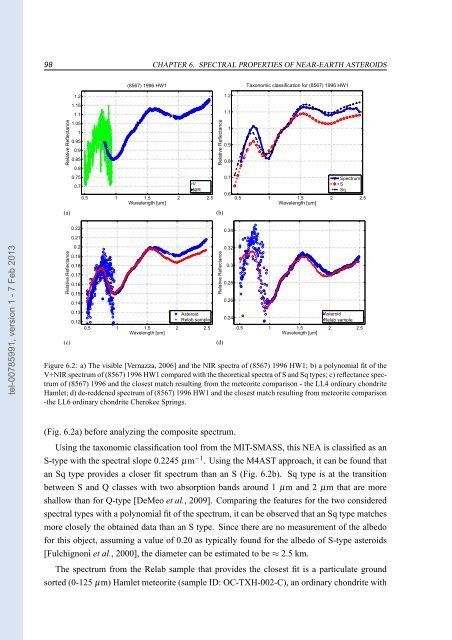Techniques d'observation spectroscopique d'astéroïdes
Techniques d'observation spectroscopique d'astéroïdes
Techniques d'observation spectroscopique d'astéroïdes
You also want an ePaper? Increase the reach of your titles
YUMPU automatically turns print PDFs into web optimized ePapers that Google loves.
98 CHAPTER 6. SPECTRAL PROPERTIES OF NEAR-EARTH ASTEROIDS<br />
(8567) 1996 HW1<br />
Taxonomic classification for (8567) 1996 HW1<br />
1.2<br />
1.2<br />
Relative Reflectance<br />
(a)<br />
1.15<br />
1.1<br />
1.05<br />
1<br />
0.95<br />
0.9<br />
0.85<br />
0.8<br />
0.75<br />
0.7<br />
V<br />
NIR<br />
0.5 1 1.5 2 2.5<br />
Wavelength [um]<br />
Relative Reflectance<br />
(b)<br />
1.1<br />
1<br />
0.9<br />
0.8<br />
0.7<br />
0.6<br />
Spectrum<br />
S<br />
Sq<br />
0.5 1 1.5 2 2.5<br />
Wavelength [um]<br />
tel-00785991, version 1 - 7 Feb 2013<br />
Relative Reflectance<br />
(c)<br />
0.22<br />
0.21<br />
0.2<br />
0.19<br />
0.18<br />
0.17<br />
0.16<br />
0.15<br />
0.14<br />
0.13<br />
Asteroid<br />
0.12<br />
Relab sample<br />
0.5 1 1.5 2 2.5<br />
Wavelength [um]<br />
Relative Reflectance<br />
(d)<br />
0.34<br />
0.32<br />
0.3<br />
0.28<br />
0.26<br />
0.24<br />
Asteroid<br />
Relab sample<br />
0.5 1 1.5 2 2.5<br />
Wavelength [um]<br />
Figure 6.2: a) The visible [Vernazza, 2006] and the NIR spectra of (8567) 1996 HW1; b) a polynomial fit of the<br />
V+NIR spectrum of (8567) 1996 HW1 compared with the theoretical spectra of S and Sq types; c) reflectance spectrum<br />
of (8567) 1996 and the closest match resulting from the meteorite comparison - the LL4 ordinary chondrite<br />
Hamlet; d) de-reddened spectrum of (8567) 1996 HW1 and the closest match resulting from meteorite comparison<br />
-the LL6 ordinary chondrite Cherokee Springs.<br />
(Fig. 6.2a) before analyzing the composite spectrum.<br />
Using the taxonomic classification tool from the MIT-SMASS, this NEA is classified as an<br />
S-type with the spectral slope 0.2245 µm −1 . Using the M4AST approach, it can be found that<br />
an Sq type provides a closer fit spectrum than an S (Fig. 6.2b). Sq type is at the transition<br />
between S and Q classes with two absorption bands around 1 µm and 2 µm that are more<br />
shallow than for Q-type [DeMeo et al., 2009]. Comparing the features for the two considered<br />
spectral types with a polynomial fit of the spectrum, it can be observed that an Sq type matches<br />
more closely the obtained data than an S type. Since there are no measurement of the albedo<br />
for this object, assuming a value of 0.20 as typically found for the albedo of S-type asteroids<br />
[Fulchignoni et al., 2000], the diameter can be estimated to be ≈ 2.5 km.<br />
The spectrum from the Relab sample that provides the closest fit is a particulate ground<br />
sorted (0-125 µm) Hamlet meteorite (sample ID: OC-TXH-002-C), an ordinary chondrite with
















